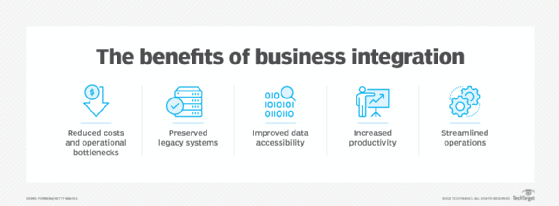business integration
What is business integration?
Business integration is a strategy whose goal is to synchronize IT and business cultures and objectives and align technology with business strategy and goals. Business integration is a reflection of how IT is being utilized as a function of business.
Business integration has many implications for the role of the corporate CIO, one of which is that the CIO will be taking on additional responsibilities such as business process management. In the past, the CIO was mainly responsible for IT processes. As technology increasingly becomes an embedded business function, IT decisions and leadership will fall under the domain of business leaders instead of technology experts.
Why is business integration important?
Computers, storage, networks and other IT resources have long been treated as a separate layer or a technological endeavor used to digitize the traditional human processes of running a business. For example, rather than writing and handling an order on paper, the order was entered and handled using computers. For many decades, IT basically displaced or augmented traditional human processes, but wasn't seen as bringing much more to the business. Thus, IT was considered an unavoidable cost center or business expense, as computers and storage replaced paper documents and file cabinets. But IT had no direct effect on any aspect of the business or the products and services the business delivered.
This attitude began to change as businesses realized that the organization's IT assets can offer more than just a digital office. The central notion of business integration is that IT should really exist as a service or business-enabler that could reduce costs, streamline business operations yet reduce errors, enhance transparency and compliance, and offer new opportunities and capabilities that would be impossible otherwise. IT should help the business get where it wants to go. Consequently, there are several key aspects to business integration, including the following:
- Alignment. IT isn't a corporate science experiment. Technology isn't procured and deployed for its own sake. IT serves the business and business integration aligns IT with business goals.
- Services. IT isn't a room full of expensive hardware. Business integration seeks to transform those assets into business services. For example, a data center server may instead be regarded as an application platform where a business leader can deploy a new software application.
- Acceleration. IT is least efficient when it shadows traditional human actions. Business integration seeks to use automation and orchestration to connect and streamline business processes and workflows. This uses IT to speed up the business, save money and bring more consistency with fewer errors to business operations.
- Innovation. IT can enable business leaders and employees to do things that are more creative and competitive. Business integration seeks to use IT to enable new opportunities for business. As one example, a business might employ internet of things devices and artificial intelligence to enhance product transportation or other supply chain activity.

How does business integration work?
The notion of business integration may seem simple, but actually implementing an integration strategy can be strikingly complex. There are as many different business integration models as there are businesses -- one size does not fit all -- and there's no single approach that works for every business or even every department within the same business.
A business integration initiative typically involves the same kinds of elements and considerations that might be found in other IT projects such as the following:
- Collaboration. Every business integration effort must involve decision-makers from both the business and IT domains. Clear communication and collaboration are essential.
- Planning. Understand the goal and ask why a business integration effort is important. What does the business need to achieve and how can IT facilitate those goals? Know what the end result should look like.
- Requirements. With goals in mind, leaders can consider the requirements for successful integration. These might involve new hardware, better documentation, new applications or APIs for workflow automation.
- Scale. An integration initiative is best approached as a series of smaller steps or phases. Starting small reduces business disruption and enables problems to be identified and resolved more easily. Such test runs can be used as proof-of-principle projects to demonstrate value before expanding into other areas.
- Repeat. A business integration project often follows a developer-style loop, with results evaluated and looped back for change and refinement over time as business needs change.
Benefits of business integration
Business integration can provide a range of benefits to the business, including the following:
- Optimization. Business integration can reduce costs and operational bottlenecks by creating streamlined and optimized processes or workflows.
- Cloud utilization. There are countless options for cloud utilization and businesses integration can enhance operations by moving some infrastructure and workloads into the cloud, including IaaS, PaaS and SaaS cloud resources.
- Preserve legacy systems. Many businesses face compelling reasons to use older legacy workloads. Business integration can help to make legacy workloads interoperable with other newer workloads and workflows, enabling legacy systems to continue working while replacement systems are developed and refined.
- Innovation. Business integration can help a business drive digital transformation and create new assets and services, enabling the business to innovate and compete in ways never before possible. One example is creating a private cloud to facilitate a strong software development team.
- Agility. Business integration can help to make the business more responsive and agile, enabling employees and customers to access data, place and track orders, or request service as part of a well-established workflow.
- Consistency. Traditional manual business processes are prone to errors and oversights that can damage customer satisfaction and even violate compliance requirements. Business integration can bring orchestration and automation that helps eliminate such problems and delivers repeatable, auditable work.
Disadvantages of business integration
While business integration is an essential need with benefits for most modern digital organizations, there are also several potential disadvantages that require consideration such as the following:
- Requires understanding. Business integration doesn't happen automatically. Digitizing, orchestrating and automating complex business processes and workflows demands a deep understanding of the business and its security, compliance and operational needs. Otherwise, it's easy to create and orchestrate errors and inefficiency into the processes.
- Less flexible. While business integration can accelerate the pace of everyday business, the use of orchestration and automation demand guardrails to ensure that events occur in predictable, repeatable patterns. There's less accommodation for unforeseen or special circumstances.
- Change. Any business integration initiative must include ample provisions for change as business needs and legal or regulatory requirements shift over time. This usually involves regular assessments of the business integration environment and a mechanism to approve and implement changes as required.
B2B integration
The meaning of business integration can extend beyond internal resources, services, processes and workflows. The notion of business integration increasingly involves the integration of two or more independent business entities -- sometimes referred to as business-to-business (B2B) or supply chain integration.
In simple terms, B2B integration is the use of IT to connect systems, data and processes that enable one business to interoperate or integrate with another to create a digital ecosystem.
As one simple example, company A places an order with company B. Company B completes and ships the order to company A using the services of company C. Company B updates company A on the status of the order, and company A can track the location and status of the delivery through company C. Such interactions require a new level of business integration capable of exchanging data and communications using APIs, integration software such as supply chain management platforms, and other tools.
It's worth noting that the term business integration is also used in discussing mergers and acquisitions. In this context, businesses are being blended together -- or integrated -- but this level of integration relies mainly on human negotiation and contractual agreement rather than IT as the primary mechanism for success.
With business integration comes more responsibilities for the CIO, which include BPM. Learn what benefits BPM provides.







